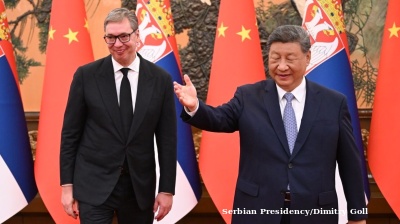Kosovo’s economy is projected to expand by 4.1% in 2025, supported by strong private consumption and investment, according to the latest assessment by the central bank.
Average inflation is expected to stabilise at around 3.3%, up from just 1.6% last year, largely due to global price movements and higher domestic demand.
The projections follow a period of robust growth. Kosovo’s economy expanded by 4.4% in 2024, driven by household consumption, investment, and exports, while inflation cooled significantly after peaking in 2022.
The central bank noted that Kosovo’s financial system remains stable, with prudent supervision and effective risk management. Fiscal accounts also improved, with a minimal budget deficit and a declining public debt-to-GDP ratio. However, policymakers warned that external uncertainties, including global market volatility, still pose risks, while a widening current account deficit and reliance on remittances remain structural challenges.
Data from the statistics agency shows that Kosovo’s GDP grew by 3.6% year-on-year in the first quarter of 2025, easing from 4.1% in the final quarter of 2024. In real terms, quarterly GDP reached nearly €2.2bn. Despite the deceleration, growth was broadly based across sectors.
Construction registered the strongest expansion at 9.8%, reflecting sustained investment. Financial and insurance activities rose 5.2%, while scientific, technical, and administrative services gained 4.5%. Manufacturing grew 4.5%, with public administration, education, health and social services increasing over 4.2%.
Trade, transport, accommodation, and food services rose 4.1% in the first quarter of 2025, supported partly by diaspora visits, while arts, entertainment, and other household services expanded by 3.2%.
Information and communication posted 3.1% growth, agriculture 2.9%, and energy, water, waste and extractive industries 1.6%. Real estate saw only modest gains of 0.8%.
On the demand side, exports of goods and services jumped 12.1%, but imports climbed even faster at 14.4%, underscoring persistent trade imbalances. Gross capital formation surged 13.6%, while household consumption grew 4.3%.
The European Bank for Reconstruction and Development (EBRD) in May 2025 trimmed its growth forecast for Kosovo to 3.9% for both 2025 and 2026, a marginal 0.1 percentage point cut from its February outlook.
The EBRD highlighted that inflation pressures also eased dramatically, falling from a peak of 14.2% in July 2022 to below 2% in early 2025. Still, risks remain, particularly from external shocks such as new US import tariffs, which could indirectly reduce remittances if eurozone economies weaken.
In June, the World Bank projects slightly lower GDP growth at 3.8% for 2025, driven by private consumption and infrastructure investment. It warned, however, that slower-than-expected implementation of public projects and external trade uncertainties could weigh on the outlook.
Among Western Balkan economies, Kosovo is expected to record the strongest growth this year, ahead of Serbia (3.5%) and Albania (3.2%). The World Bank sees growth for the region as a whole at 3.2% in 2025, rising to 3.5% in 2026.
Kosovo’s growth has remained steady over the past few years, with GDP expanding 4.3% in 2022, 4.1% in 2023, and 4.4% in 2024.
Data

Kazakhstan’s services sector cools to weakest pace since March, PMI shows
Business confidence hits 28-month low. Companies cautious with new tax rules on horizon.

Thailand’s monetary easing cycle set to stretch into 2026
According to projections from the Bank of Thailand, as the central bank grapples with faltering growth, external headwinds and limited inflationary pressure, the nation’s policy of monetary easing is likely to continue past the new year into 2026.

Turkey's official inflation creeps up to touch over 33% y/y in September
Central bank wants figure below 30% by year's end.

Ukrainian ports hit wartime record in container handling
Ukrainian ports processed 134,191 TEU in 8M25, more than during the whole of 2024, according to the Association of International Freight Forwarders of Ukraine.




